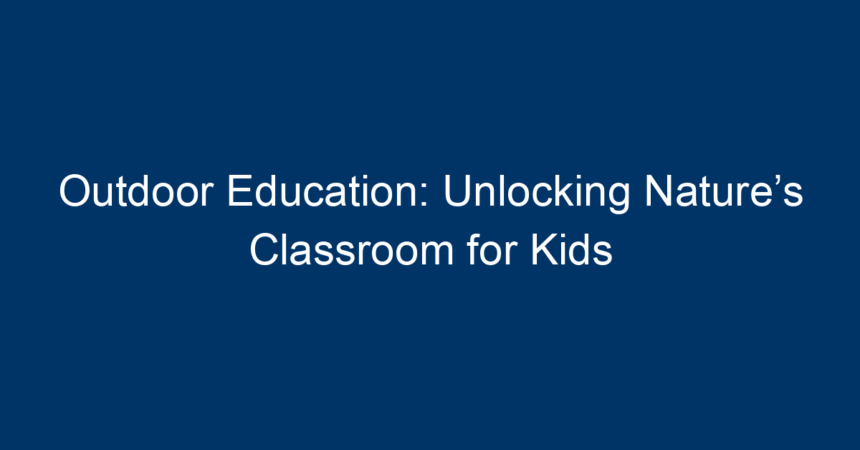In an age where technology dominates children’s lives, the importance of outdoor education has never been clearer. Outdoor education offers kids a unique way to engage with the world around them, fostering not only academic skills but also essential life skills. By immersing children in nature, educators can unlock a treasure trove of learning opportunities, encouraging exploration, creativity, and critical thinking. This article delves deep into the benefits, implementation, and best practices of outdoor education for kids, equipping parents and educators with the tools needed to unlock nature’s classroom.
What Is Outdoor Education?
Outdoor education refers to a teaching approach that uses the natural environment as the primary classroom. This method contrasts sharply with traditional classroom settings, promoting experiential learning through hands-on activities in nature. Key components of outdoor education include:
- Experiential Learning: Students learn by doing, engaging all their senses to understand concepts deeply.
- Personal Growth: Outdoor education helps develop leadership skills, resilience, and teamwork.
- Curriculum Integration: Subjects like science, math, and art can be seamlessly integrated into outdoor activities.
Overall, outdoor education cultivates a holistic learning experience that extends learning beyond the four walls of a classroom.
The Benefits of Outdoor Education
1. Enhancing Academic Performance
Research consistently shows that students engaged in outdoor education perform better academically. The vibrant, dynamic environment stimulates curiosity and promotes active engagement. Subjects like science become tangible and relatable when studied in a natural setting. For instance, observing plant life cycles in a garden or studying animal habitats firsthand can deepen understanding and retention.
2. Promoting Physical Health
Incorporating outdoor education into children’s routines encourages an active lifestyle. Being outdoors promotes physical activity, which is crucial for combating obesity rates among children. Activities like hiking, climbing, or even simple nature walks provide kids with the exercise they often miss in traditional settings.
3. Fostering Emotional Well-Being
Nature has a unique way of calming the mind and soul. Outdoor education can significantly reduce stress and anxiety levels in children. Engaging with natural surroundings has been linked to improved mood and emotional regulation. The freedom to explore freely allows children to express themselves and find solace in their surroundings.
4. Encouraging Social Skills
Outdoor education programs also serve as a catalyst for social interaction. Group activities require teamwork and collaboration, essential skills in today’s interconnected world. Whether building a shelter or navigating a trail, kids learn to communicate, negotiate, and work together effectively.
Key Components of Effective Outdoor Education Programs
1. Curriculum Integration
A successful outdoor education program dovetails with the existing curriculum. By identifying key learning objectives from traditional subjects and finding ways to meet them outdoors, educators create a rich, multi-disciplinary experience. For instance, a science lesson on ecosystems can easily transition to a field trip to a local park or nature reserve.
2. Safety First
Safety is paramount in outdoor education. Educators should familiarize themselves with the potential hazards of outdoor activities. Proper planning includes identifying risks, conducting risk assessments, and ensuring all necessary safety gear is available. Kids should also be educated on safety protocols, fostering a sense of responsibility.
3. Variety of Activities
Diversifying outdoor education activities keeps kids engaged and excited. Incorporating a mix of physical challenges, artistic endeavors, and scientific explorations ensures that every child finds something that resonates with them. Activities can range from nature scavenger hunts and environmental stewardship projects to storytelling sessions by the campfire.
4. Connection with Nature
Fostering a deep connection with the environment is the ultimate goal of outdoor education. Encourage children to observe, ask questions, and reflect on their surroundings. Activities such as journaling about their experiences or participating in conservation efforts can deepen their appreciation for nature.
Popular Outdoor Education Activities for Kids
1. Nature Walks and Hikes
Nature walks provide children with a first-hand experience of ecosystems, biodiversity, and the importance of conservation. Educators can organize guided hikes where students learn to identify plants, animals, and natural landmarks.
2. Team Challenges and Ropes Courses
These activities are designed to build teamwork and confidence. Kids work together to overcome physical challenges, fostering collaboration and trust. This not only enhances their social skills but also helps build resilience.
3. Gardening Programs
Engaging children in gardening teaches them about responsibility, biology, and nutrition. Kids learn how to plant seeds, nurture them, and eventually harvest their crops. This hands-on experience nurtures a sense of accomplishment and respect for the earth.
4. Outdoor Art Projects
Art can seamlessly blend with outdoor education. Encourage children to create land art using natural materials like leaves, stones, and twigs. This promotes creativity while also helping them connect with their surroundings.
Implementing Outdoor Education at Home
Parents can play a pivotal role in fostering outdoor education at home. Here’s how to encourage this learning approach:
1. Explore Local Parks and Nature Reserves
Making a habit of visiting local parks or nature reserves can foster a love for the outdoors. Plan regular outings where the family can hike, picnic, or simply enjoy the beauty of nature.
2. Encourage Outdoor Play
Limit screen time and promote outdoor play. Activities like climbing trees, riding bikes, or playing sports encourage physical activity and creativity, crucial for a child’s development.
3. Participate in Community Programs
Many communities offer outdoor education programs or workshops designed for children. These programs often incorporate valuable skills such as environmental stewardship and conservation awareness.
4. Lead by Example
Children emulate their parents. Show enthusiasm for outdoor activities, perhaps by starting a family garden or organizing weekend hikes. Your involvement will inspire them to appreciate and enjoy the great outdoors.
Conclusion: Unlock Nature’s Classroom
Outdoor education is more than a trend; it’s a vital component of a well-rounded education that nurtures physically, emotionally, and academically thriving children. As parents, educators, and community members, we have the opportunity to unlock nature’s classroom for kids, enriching their lives in countless ways.
By prioritizing outdoor learning experiences, we not only cultivate a deeper appreciation for nature in our children but also equip them with essential skills that will serve them throughout their lives. Embrace outdoor education today—it’s time to let children roam, explore, and learn in the great outdoors!




